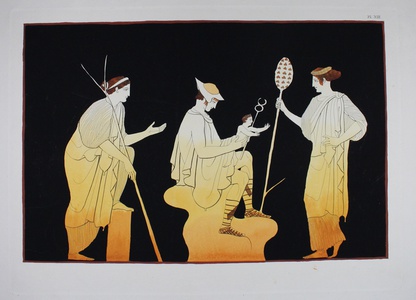| Method | Copper engraving with hand colouring |
| Artist | Antoine Clener |
| Published | A Paris de l'Imprimerie de P. Didot l'Aine MDCCCX [1810] |
| Dimensions | Image 235 x 355 mm, Plate 280 x 385 mm, Sheet 415 x 555 mm |
| Notes |
A depiction of a red-figure vase decoration of part of the Bacchic myth cycle, Plate 13 from Volume 2 of Peintures de vases antiques, vulgairement appelés étrusques. The scene depicts the youth of Dionysus (Roman Bacchus), god of wine. Having been left without a mother through the death of Semele, the infant was taken by the messenger god Hermes (Roman Mercury) to the grove of the nymphs of Nysa, where he was nurtured and raised. At the centre of the scene, Hermes is shown with broad-brimmed hat and laced sandals, holding the young god, who reaches out towards his new nurses. Hermes' staff, the caduceus, can be seen behind the infant. The two nymphs are dressed similarly in heavy peplos and cloaks, though each carries a distinctive staff, representing the two most popular forms of Dionysus' thyrsus, the two-pronged fork and the pinecone-topped branch. Peintures de vases antiques, vulgairement appelés étrusques was an early nineteenth century French answer to the hugely popular and influential series of engravings and descriptions of Greek vases assembled by Sir William Hamilton, the British envoy to the Kingdom of Naples and Sicily. Following the withdrawal of the British from Bourbon Naples, in the face of Napoleon and the revolutionary army, the excavations of archaeological sites in the region yielded numerous examples of Greek red-figure vases for French museums, galleries, and private collectors. Authored by Aubin-Louis Millin de Grandmaison, the leading French authority on Greek vases, and featuring illustrations by Antoine Clener, the two-volume publication featured examples of Greek vase painting from the Malmaison, the Musee Napoleon, the Bibliotheques imperial and nationale, and numerous private French collections. In style, it closely resembled the two different editions illustrating Hamilton's vases. The artist Clener had even been the pupil of Hamilton's artist Tischbein during the preparation of plates for his second publication. Akin to this second Hamilton collection, the plates in the Peintures de vases antiques were left uncoloured at publication, ostensibly for the benefit of artists and academics wishing to study the fine details of line and composition, though the publication contained a similar note to connoisseurs that with the assistance of a skilled colourist, the full impact of these masterworks of classical art could be appreciated by the discerning collector. Antoine Clener (fl.1790-1810) was a French engraver, principally known for his plates of Greek vases. As a young man, he worked as a pupil of Johann Heinrich Wilhelm Tischbein, and it was likely through his master's work on the Hamilton vases that gained him his most notable commission producing copper engraved plates for Millin de Grandmaison's Peintures de vases antiques, vulgairement appelés étrusques. Aubin-Louis Millin de Grandmaison (19th July 1759 – 14th August 1818) was a French author, antiquarian, connoisseur, and natural historian. Having fallen foul of the Jacobins and removed from his editorship of the Chronique de Paris, he was later appointed the chair of archaeology at the Bibliotheque nationale, expanding the institute's holdings of classical and medieval art, and becoming, in the last decades of his life, a specialist on the subject of classical vase painting. In addition to his antiquarian work, he was also a prominent member of the naturalist community, founding the world's first Linnean Society. Condition: Minor time-toning to edges of sheet. Otherwise a strong impression in superb heavy colour. |
| Framing | unmounted |
| Price | £300.00 |
| Stock ID | 43480 |

